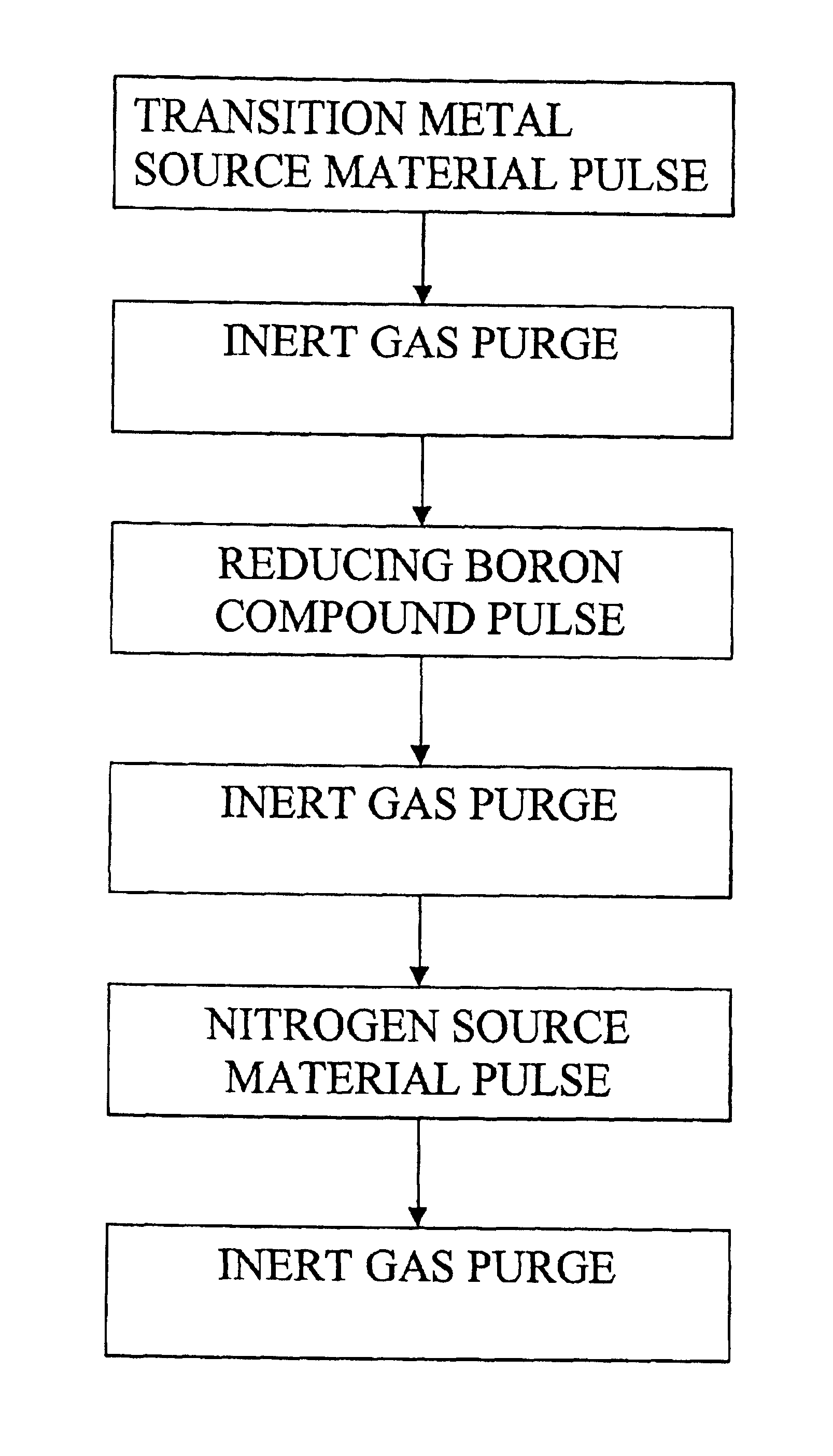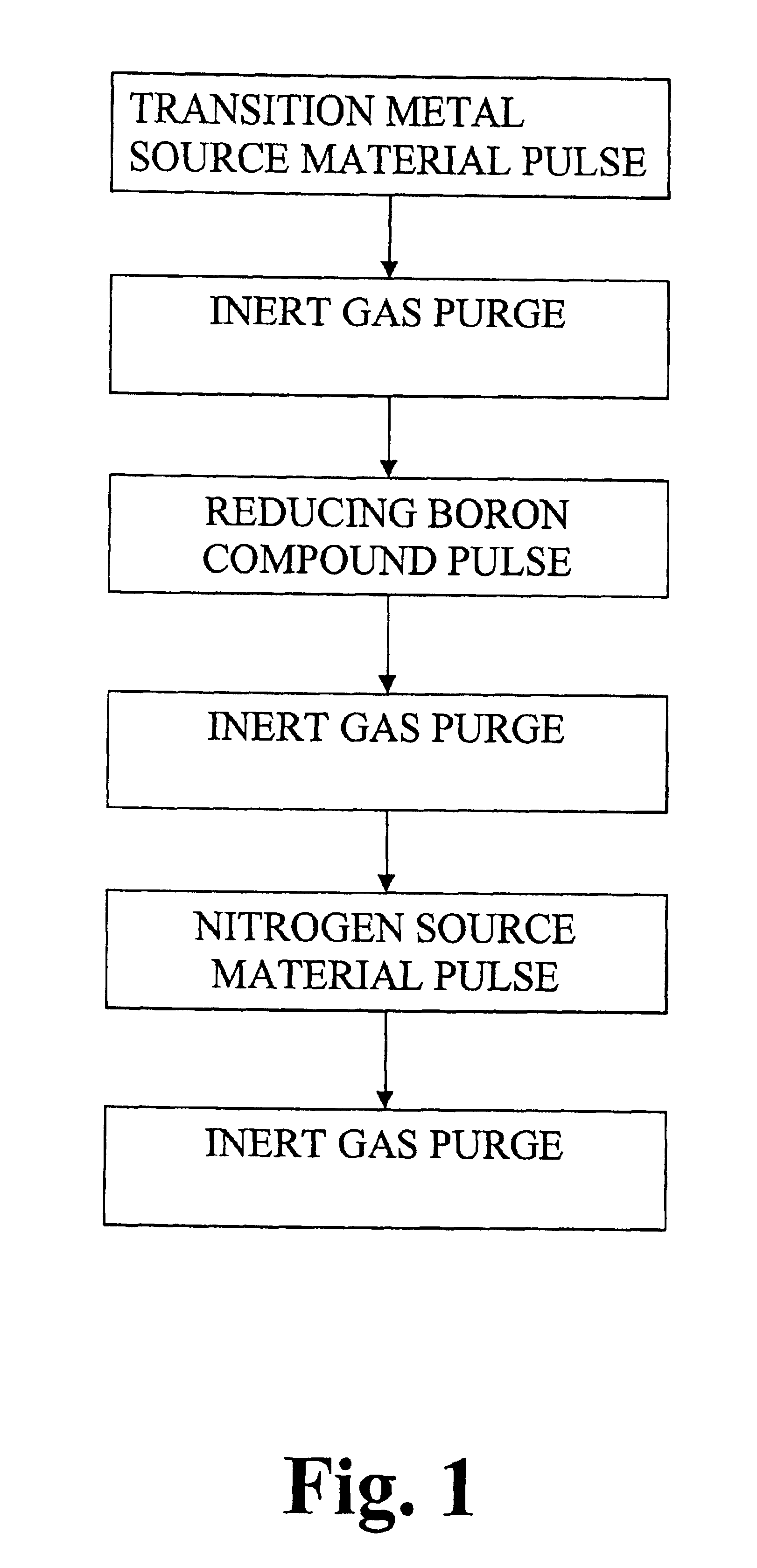Method of depositing transition metal nitride thin films
a technology of transition metal nitride and thin film, which is applied in the direction of crystal growth process, chemical vapor deposition coating, coating, etc., can solve the problems of affecting the electrical properties of the circuit, and copper is prone to diffusion to the surrounding materials, etc., to achieve low resistivity, easy to handle, and acceptable growth rate of the film
- Summary
- Abstract
- Description
- Claims
- Application Information
AI Technical Summary
Benefits of technology
Problems solved by technology
Method used
Image
Examples
example 1
Tungsten hexafluoride (WF6) and ammonia (NH3) were used as source chemicals. Both chemicals are liquefied gases at room temperature and posses high enough vapor pressure without additional heating for the ALD process. Source tubing and the reactor were purged with nitrogen gas which had a purity of 99.9999% (i.e. 6.0). The N2 gas was prepared from liquid nitrogen. A 200-mm silicon wafer was loaded to an ALD reactor as described in Finnish Patent No. 100409 of assignee. Source chemicals were pulsed alternately to the substrates at the reaction chamber. The deposition was started and ended with an NH3 pulse. The pulsing cycle consisted of the following steps:NH3 vapor pulse 0.5 sN2 gas purge 1.0 sWF6 vapor pulse 0.25 sN2 purge 0.8 s
The pulsing cycle was repeated for 500 times which produced a 30 nm film with the typical growth rate of 0.6 Å / cycle. The composition, impurities and the thickness of the resulting thin film were analyzed by Electron Diffraction Spectroscopy (referred to as...
example 2
Tungsten hexafluoride (WF6), triethylboron (CH3CH2)3B and ammonia (NH3) were used as source chemicals. All the chemicals are liquids or liquefied gases at room temperature and poses high enough source vapor pressure without additional heating for the ALD process. Source tubing and the reactor were purged with nitrogen gas which had a purity of 99.9999% (i.e. 6.0). The N2 gas was prepared from liquid nitrogen. A 200-mm silicon wafer was loaded to an F200 ALD reactor. Source chemicals were pulses alternately to the substrates at the reaction chamber. The pulsing cycle consisted of the following steps:WF6 vapor pulse 0.25 sN2 purge 0.8 s(CH3CH2)3B vapor pulse 0.01 sN2 gas purge 0.5 sNH3 vapor pulse 0.25 sN2 gas purge 0.5 s
The pulsing cycle was repeated for 500 times resulting in a 30-nm film at 360° C. The samples were analyzed by EDS for thickness and composition. The thin film consisted of tungsten and nitrogen while boron could not be seen in detectable amounts. There was 3 wt.-% of...
PUM
| Property | Measurement | Unit |
|---|---|---|
| feature sizes | aaaaa | aaaaa |
| thickness | aaaaa | aaaaa |
| pressure | aaaaa | aaaaa |
Abstract
Description
Claims
Application Information
 Login to View More
Login to View More - R&D
- Intellectual Property
- Life Sciences
- Materials
- Tech Scout
- Unparalleled Data Quality
- Higher Quality Content
- 60% Fewer Hallucinations
Browse by: Latest US Patents, China's latest patents, Technical Efficacy Thesaurus, Application Domain, Technology Topic, Popular Technical Reports.
© 2025 PatSnap. All rights reserved.Legal|Privacy policy|Modern Slavery Act Transparency Statement|Sitemap|About US| Contact US: help@patsnap.com


